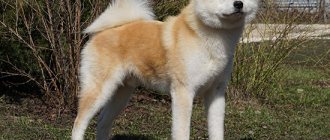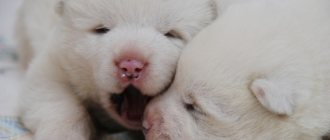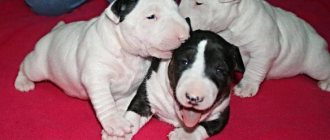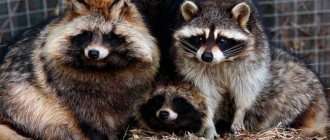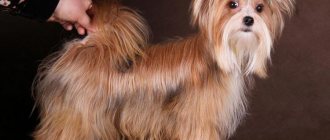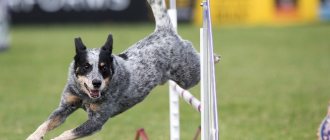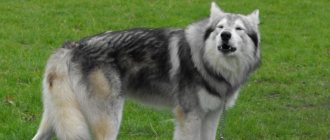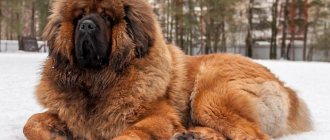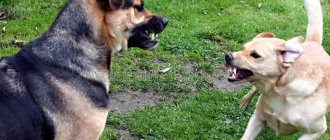Akita Inu is the most popular Japanese breed. It has been known in its homeland since ancient times. The world learned about the breed in the 20th century. She immediately attracted the attention of breeders and became popular. This dog is smart, strong and loyal. Capable of becoming a loyal friend and companion, watchman or security guard. But her character is complex, she is willful and independent. Therefore, everyone who is attracted to this breed needs to study its description, pros and cons, and reviews from owners. A photo of Akita Inu dogs shows what they look like:
- Head
- Attitude towards children
- Hygiene procedures
Breed traits
Breed traits (on a 5-point scale)
| Akita Inu | |||
| Activity | in the house | 2 | |
| on the street | 3.4 | ||
| Obedience | training | 3.1 | |
| strangers | 4.4 | ||
| Domination | in family | 2.7 | |
| over dogs | 4.7 | ||
| Defending your territory | from people | 3.4 | |
| from dogs | 4.6 | ||
| Sociability | in family | 4.6 | |
| with strangers | 2.4 | ||
| with dogs | 1.7 | ||
| Concentration | in family | 1.6 | |
| in front of strangers | 3.6 | ||
| with dogs | 3.8 | ||
| Aggressiveness | in family | 1.3 | |
| to strangers | 2.7 | ||
| to the dogs | 3.9 | ||
| to cats | 4 | ||
| Family behavior | calmness | 3.9 | |
| demand for affection | 3.9 | ||
| excitability | 3.3 | ||
| playfulness | 3.5 | ||
| excessive barking | 1.5 | ||
| behavioral breakdowns | 1.8 | ||
| Tolerance for children | up to 4 years | 3.3 | |
| over 4 years old | 3.2 | ||
| Institutional use | watchman | 4.4 | |
| bodyguard | 3.6 | ||
This breed is often compared to the following dog breeds: German Shepherd, Samoyed, Alaskan Malamute, Labrador Retriever, Cardigan Welsh Corgi.
Akita Inu in winter
Give me a paw friend
General characteristics of the Akita Inu breed
The Akita Inu is a cute, fluffy dog. It belongs to the Spitz-type breeds with developed service qualities. Height is slightly above average, hardy, active, strong. Used as a hunter, watchman, security guard, friend or nanny for children. This is one of the 14 most ancient breeds that have survived almost unchanged. Distinctive features are a triangular head, erect ears, a ringed tail and thick fluffy fur.
You can also recognize an Akita by its smiling face. This expression is obtained due to the specific structure of the mouth. Representatives of the Akita Inu breed also have special character traits inherited from their ancestors. They are smart, independent, self-reliant, loyal, and do not tolerate neglect. They can be headstrong and stubborn, so they are only suitable for an experienced owner.
| Options | Characteristic |
| country of origin | Japan |
| group of breeds according to the ICF classification | Spitz |
| life expectancy | 10-13 years |
| height | 58-65 cm |
| weight | female 23-35 kg, male up to 44 kg |
| service qualities | watchman, bodyguard, companion |
| activity | high |
| attitude towards a person | loyal, family friendly, can be aggressive |
| training | complex |
| health | good |
| care | easy, but sheds a lot |
pros
Akita is considered one of the most beautiful, intelligent and loyal pets. Despite the high cost, they have many fans. These dogs are popular because of their many benefits.
- Akita Inu live quietly both in a private house and in a city apartment. You can keep it in the yard, just don’t put it on a chain.
- These are dogs with an attractive appearance. They have a proportional build and a triangular muzzle. The peculiarity of the breed is the special structure of the jaw. Therefore, it seems that the dog is constantly smiling.
- These animals are very clean. On the street they will not get into the mud or roll around in the dust. They love to swim and have no dog smell.
- Akita Inu are very smart dogs. They are easy to learn and understand what is required of them. They easily let the owner know what they want.
- Very calm, do not like to impose themselves. They are independent and tolerate loneliness well.
- Security qualities are inherent at the genetic level. Akitas do not need to be trained to guard the house. They instinctively protect the owner, his family members, and property.
- He won't make a fuss without a good reason. They rarely bark or howl, but usually growl or snort.
- Thanks to its thick undercoat, the Akita easily tolerates cold and heat. She has good thermoregulation.
Minuses
Representatives of the breed are not without shortcomings. This seemingly cute fluffy dog is actually a strong and independent animal. To avoid problems, you need to study the disadvantages of keeping such a pet.
- This dog should be owned by a person with a strong character, self-confident and balanced. If the owner cannot gain authority, she will begin to dominate. She will not obey and will become uncontrollable.
- They do not get along well with other dogs, especially of the same sex, and can get into fights. To avoid this, you need to properly socialize.
- Very active, need high physical activity. You need to walk with your pet for a long time, run, play.
- They shed heavily. The coat needs to be brushed regularly.
- Eating problems may occur. It is difficult to choose dry food, and an allergic reaction often occurs.
- They are uncommunicative and not sociable. Without good socialization they can be aggressive towards strangers.
The video will help you learn more about the advantages and disadvantages of this breed:
Video: Akita Inu - features of the breed
Over the millennia of Akita Inu's existence, many interesting facts about it have accumulated.
- This is one of the ancient breeds, preserved almost unchanged and without impurities. Despite the fact that it almost disappeared in the 20th century, it was possible to restore the unique breed characteristics.
- Until the 17th century, Japan had the death penalty for killing an Akita. And people who hurt these dogs were sent to prison.
- The Japanese consider the Akita to be the country's treasure. This dog is a symbol of devotion, prosperity, and family happiness.
- It ranks 14th in the breed popularity ranking. This is explained not only by the character qualities of the Akita Inu, but also by its attractive appearance.
- Akita is sensitive to violation of personal space. She accepts affection only when she wants it.
- Akita Inus reach standard size by the age of 2 years. They grow and mature slowly; a dog is fully developed by the age of 3.
- Before World War II, representatives of the breed lived a long time - up to 14-15 years. After the bombing of Hiroshima, due to radiation, life expectancy became no more than 12 years.
- In 2012, a puppy of this breed was presented to the President of Russia.
History of Hachiko
The popularity of the Akita Inu breed is largely explained by the history of the dog Hachiko. It was the film about this devoted dog that made her famous in Russia and throughout the world. The Akita Inu dog accompanied his owner to the station every day and met him in the evening. But somehow the owner did not return from work; he died of a stroke. The faithful dog continued to come to the station. He waited for his beloved owner for 9 years until he died of heart disease. In Japan, everyone knew this devoted dog, and mourning was declared for him. After this, the breed was made a symbol of fidelity, and a monument was erected to Hachiko at Shibua station. A film was made about him in Japan in 1987 and a remake in 2009 in America. Pictures from the popular film “Hachiko: The Most Faithful Friend”:
Photo of Akita Inu from the movie “Hachiko: The Most Faithful Friend”
Photo of Akita Inu from the movie “Hachiko: The Most Faithful Friend”
Photo of Akita Inu from the movie “Hachiko: The Most Faithful Friend”
Types of Akita Inu
Japanese
The dog's ancestors are the Chinese Spitz dog and the mastiff. Initially, the dogs were small in size. They served as hunters of bears, deer, and wild boars. In the 19th century, a large number of other dog breeds emigrated to Japan, such as Great Danes, Bulldogs, and St. Bernards. The Japanese had a desire to cross them with Akita to obtain a breed with increased aggressiveness, which would allow them to have good guard dogs for homes and families. As a result, new varieties of the breed appeared - Karafuto, Tosa Inu, etc. Selection also influenced the Akita Inu itself. She became larger, more powerful, more temperamental and more aggressive.
American (Great Japanese)
Its occurrence is associated with sad events. During the Great Patriotic War, Japanese Akitas were exterminated because of their warm wool, which was used to make winter clothes. Directly for military service, exclusively German shepherds were used, as they were the best suited for this.
The owners of Japanese Akitas, who loved their pets and wanted to save them, began to cross them with German shepherds. The puppies that were born could easily be mistaken for German Shepherds. So, as a result of selection, the American Akita appeared. This name was given to her by the Americans, who brought the dogs they liked to the USA. Helen Adams Keller was the first to do this. In America they were warmly received. Subsequently, they decided to start breeding “Japanese”, adding size, temperament and spotty color to them. They were crossed with Bullmastiffs, English Mastiffs and other Molossians. As a result, the American analogue of the Japanese Akita differs from its ancestor in character (the American has a tougher and more straightforward disposition) and appearance:
- Height at withers. Male - 72cm, female - 67cm.
- Weight 65-70kg.
- The color can be any. Coat colors vary
- Presence of a black mask.
- The coat is medium length, hard, straight with a thick soft undercoat. The hair is shorter on the head and limbs.
- The head is more voluminous than that of the Japanese. It has the shape of a triangle with obtuse angles. Characterized by a steep transition from the forehead to the muzzle.
- The bite is like a scissors. The lips are close.
- The tip of the nose is black. White dogs are allowed a brown nose.
- The eyes are small, framed by a rainbow of brown colors.
- The ears are small. They are standing. Slightly tilted forward at a certain angle.
- The neck is large and powerful.
- The chest is muscular and extensive.
- The back is straight, strong with a powerful loin.
- The stomach is tucked.
- The legs are large and muscular. Positioned evenly and straight. Large round paws are brought together into a ball.
- The high-set, powerful fluffy tail is thrown over the back and wrapped in a ring.
American dogs have an independent character. They have a healthy psyche - self-possessed and patient. Americans do not have sudden outbreaks of aggression. When communicating with a pet, the owner needs to show attention, restraint and patience - animals cannot tolerate superficial and rude attitudes. From puppyhood, the American Akita must be taught to obey. Otherwise, due to the innate desire to dominate, she will begin to “set the tone.” The owner must immediately make it clear that he is in charge:
- The dog must obey the first command.
- Doing prohibited things should not be allowed. You need to react quickly to your dog's actions.
- The owner should always enter the house first.
- You should reward your dog for doing the right thing. This way she will understand that there is a leader next to her.
The American Akita is very sociable and peaceful. Barks rarely, but to the point. His barking really means alarm. He is indifferent to strangers who do not pose a danger to loved ones. The “American” is merciless towards those who are capable of causing harm. He expresses devotion to all family members and even close friends. In return, it also requires showing respect and love. The dog must feel that he is loved. If the animal is treated negligently, it is impossible to achieve loyalty.
It is not advisable to have an American Akita as your first dog - this is a difficult animal. The owner must have experience in raising dogs. It is recommended to train the dog in a playful way. “Americans” do not tolerate monotony and importunity. If the dog is bored with training, you should quickly change the activity and distract him with his favorite treat or toy . The dog does not need long hours of training - it is smart and remembers commands quickly, as long as it has the desire. “American” is a mood dog. The use of physical force in his upbringing is excluded. The dog will withdraw and ignore the owner.
Possessed by an innate sense of dominance, American Akitas show instant aggression towards other dogs and rush to attack. A dog owner who has not taught his four-legged pet to obey will not be able to prevent a fight. These animals love freedom so much that at every opportunity they can escape. They can escape by digging or jumping over a fence. The owner needs to know this and take appropriate measures - build fences at least 2.5 m in height and periodically inspect them for undermining. While walking, you should hold the leash tightly.
When it comes to food, dogs are more adaptable. The “American” tolerates foods that cause allergies in the Japanese Akita very well. We are talking about chicken, beef, veal. It also perfectly digests the foods that the “Japanese” eat.
Mini
Dogs of this species are half the size of the original Akita. In all other respects, these dogs are similar. The legendary dog Hachiko was precisely this type of Akita.
Dwarf
Translated from Japanese, “dwarf” means “Shiba”.
By Nippo standards, the female and male are very different in appearance. The cable is large, muscular and aggressive. Miniature female, good disposition. Dogs are friendly, cheerful and smart.
Origin of the Akita Inu dog breed
Akita Inu is the largest Japanese dog breed. The name translates as “dog from the Akita province.” In appearance it is similar to a Shiba Inu or a “Japanese dwarf”, they differ only in size. These are dogs from the Spitz group, descended from the ancient matagi ken, which were used in ancient times to hunt large animals, even bears. The ancestors of modern Akitas lived on the islands of Japan 8 thousand years ago. Archaeologists have found many images of such dogs in ancient tombs. Ancient hunting dogs were strong, hardy, and could withstand harsh climatic conditions. Of these, people began to select those who were more attached to home and person.
Selection was carried out in the province of Akita. These calmer and more loyal dogs began to be used as guard dogs. The emperor liked the new breed and became popular among the nobility. The first documents describing such dogs date back to the 17th century. Their peculiarity is that no other breeds were used during selection, so they retained all the characteristics of ancient dogs.
Akita Inus are valued in Japan, it was forbidden to offend them, even to raise your voice. In the imperial palace, every dog had a servant. They were considered sacred, and in the 20th century they were declared “natural monuments” and “treasures of Japan.”
In the 19th century, they tried to cross native Japanese breeds with dogs brought from Europe, trying to improve them and increase their size in order to use them in dog fighting. Because of this, they began to lose their breed characteristics and became aggressive.
At the beginning of the 20th century, a society was created to preserve native Japanese breeds. The most famous of them are the Akita and Shiba Inu. They were prohibited from crossing with other breeds. In the 30s, the first standard was created, the breed was registered under the name Akita Inu. Another test awaited these dogs during World War II. They took part in battles and were almost exterminated. Some representatives of this breed were preserved thanks to fanciers who hid them in remote villages. And after the war its revival began. At the same time, a second breed line appeared - the American Akita Inu. These dogs were bred from individuals brought to America by the military. This is how the ancient Japanese breed spread throughout the world. Interesting historical photos and pictures:
Historical photo of Akita Inu dog
Historical photo of Akita Inu dog
Historical photo of Akita Inu dog
Popular Akita Inu colors
In the film "Hachiko" a red-and-white dog was filmed. She brought such popularity to this breed. Now this is the most popular and sought after color, but the breed has many colors.
Akita-inu variety
Akita Inu sesame color
This color can be considered a rarity, as it is now difficult to find. The coat color ranges from light peach to bright red. The undercoat is always lighter than the main hair.
White Akita Inu
This color is rarely seen in Russia, but not in Japan. The white Akita does not have any extraneous shades. Light fur combined with dark eyes and a black nose looks very impressive.
Interesting fact! A dog of this breed up to two years of age is considered a puppy. He is very playful and uncontrollable. But everything will change when the puppy grows up.
Black Akita Inu
It is extremely difficult to meet a dark black Akita. Upon careful examination, most colors can be classified as sesame or even brindle. The difference is that there are not clearly defined stripes. The true black color is absolutely black, without any transitions. If they are still present, then this is no longer a black color.
The brown Akita also has dark fur. This coloring is found in dogs belonging to the American variety. They are quite large and have a strong and powerful build.
Akita Inu brindle color
Akita Inu brindle can have white fur with red stripes or, on the contrary, red fur with white stripes. The striped color resembles brindle. The Japanese Tiger Akita Inu is very popular all over the world.
Tiger Akita Inu
Description and standard of the Akita Inu breed
Akita Inu is a dog with a strong, graceful build and belongs to large breeds. According to the ICF classification, it is included in the Spitz group. The height of Akita Inu reaches 65 cm, females are slightly smaller - up to 61 cm. Girls have a more slender and elongated body, boys have an almost square physique. The weight of an Akita Inu male is 45-59 kg, females 32-45 kg.
Head
The head is medium in size, consistent with the proportions of the body, elongated, reminiscent of a fox. The fur on the face is short, a white pattern in the form of a mask is required. The forehead is wide and flat, the stop is clearly defined, the nose is pointed. The jaws are strong, have a scissor bite, and the lips fit tightly. The nose is black. The ears are small, triangular, pointed at the ends. Set wide apart, erect in an adult dog. They do not rise immediately; in puppies they are lowered. The ears are movable and, when at rest, point slightly to the sides. The eyes are dark and located close to the nose. The outer corners are slightly raised. The fur on the face is fluffy, making the eyes appear small. But the look is insightful and intelligent.
Body type
The physique is muscular and strong. The neck is short, with a small collar. Possible folds and loose skin. The chest is wide, slightly concave, the stomach is well tucked. The back is straight, short, the loin is wide. The tail is thick and fluffy. Usually rolled into a ring or thrown over the back. Never straightens completely.
Limbs
The limbs appear short in relation to the body. They are straight, parallel, muscular. The front legs are spread wide, the hind legs are shifted. The dog can jump high. Moves easily and quickly. The toes are closed and very strong. Thanks to this, Akitas swim very well. The photographs show the appearance features:
Appearance Akita Inu
Appearance Akita Inu
Features of wool
The coat is short, up to 5 cm long, straight and very thick. Because of this, dogs do better in cold climates. There is a soft fluffy undercoat, the guard hair is hard, two-layered. Longer at the withers, tail and hind legs.
Akita Inu colors
One color of these dogs is popular among Japanese Akita Inu breeders. They should be fawn with white areas. The color is heterogeneous, in dark areas the top layer is red. The undercoat is completely white. There should also be white markings on the chest, neck, belly, legs, nose and inside of the tail. Several more colors are recognized as standard:
- sesame or black-brown with white markings;
- pure white Akita Inu, red hair on the back is allowed;
- brindle - black stripes on the standard color, rare;
- spotted;
- black.
Photos of the main colors of Akitas:
Akita Inu color white
Akita Inu color brindle
Akita Inu color is fawn-red with white areas
Akita Inu color brindle and fawn
Longhair
Sometimes there are long-haired Akita Inus. The standard does not recognize such individuals, classifying long hair as a fault. But such a gene is recessive, that is, a long-haired puppy can appear from ordinary parents. Researchers believe that it appeared due to the fact that Sakhalin huskies were used to restore the breed.
Characteristics of American Akita Inu
This breed variety appeared after World War II. American Akitas were bred in the USA from puppies brought by the military. They chose the more powerful large representatives of the breed. They were crossed with German shepherds and mastiffs. Therefore, the resulting dogs were slightly different from purebred Japanese Akitas. They began to be called “big Japanese dogs” or American Akita. Now these are two different breeds; they were officially separated in 1999. American Akitas are not recognized in Japan. Despite their common origin, they have the following differences from ancient dogs:
- larger, bear-like skull;
- height up to 70 cm, weight 65 kg;
- colors are allowed: black and white, piebald, spotted, brindle;
- the coat may be long;
- are more flexible in nature.
The pictures show the difference between American Akitas and Japanese ones:
Photo of American Akita Inu
Photo of an American Akita Inu with long hair
Photo of American Akita Inu
Sesame Akita Inu
This color is becoming rare nowadays, even in the 50s. 20th century was the most common among Akita Inu representatives. This is a red “mantle”, but with a peculiar black “belt” on the back and a snow-white bottom. As for red representatives, the white underside is important here - the chest, belly, inner parts of the paws, tail, cheeks and lower jaw. Everyone sympathizes with Kadyrov’s grief: the sad news shocked people Scandal on Channel One: a famous presenter turned out to be a man who had changed his sex Scientists have discovered a frightening feature in everyone who died from COVID-19: Today, sesame color is practically not involved in selection. In the Japanese homeland of the breed, it is no longer popular; in Russia there are practically no such dogs. Due to the similarity of colors, these representatives of the breed were often called “Japanese Shepherds.” Pictured are sesame Akita Inu:
Description of the character of Akita Inu
Akita Inu is a Spitz-type dog. Like all representatives of these breeds, she is strong, courageous and temperamental. Her ancestors hunted large animals and protected the house from bandits. This has affected the character of modern pets. They have the following qualities:
- equilibrium;
- temperament;
- curiosity;
- good nature;
- restraint;
- independence;
- courage;
- endurance;
- patience;
- love of freedom.
The main feature of the Akita is loyalty and devotion to the owner. She always wants to be close to him, and it’s hard for her to experience separation. It’s not for nothing that Hachiko was made a symbol of this quality. Dogs remain faithful in any conditions and are ready to protect their owner, regardless of pain, hunger or other inconveniences. Akitas have a good memory. They remember everything: tone of voice, words, insults.
These pets are touchy and vulnerable. They do not tolerate criticism or raising their voice; a serious punishment for the dog is the cessation of communication. But despite this, the dog is not capable of dirty tricks, will not take revenge or misbehave at home, and is not prone to aggression. But these menacing-looking dogs are affectionate and gentle with family members. They are very emotional, although they may not show emotions outwardly, controlling them. They are able to feel a person’s mood and support him in difficult times, listen, and share joy. Dogs' independence and intelligence are often mistaken for cunning and stubbornness. But if you find a common language with your pet, such behavior will not cause inconvenience.
Attitude towards children
Akita loves children very much, protects them, and monitors their safety. It’s not for nothing that in Japan, representatives of the breed are used as nannies. The pet will constantly try to spend time with the child and play. Photos illustrate the peculiarities of communication between these dogs and people:
Photo of Akita Inu with people
Photo of Akita Inu with children
Photo of Akita Inu with a child
Service qualities
Akita Inu is the second most popular dog breed used in canistherapy. They can work in hospitals and rehabilitation centers. They help sick people recover and have a beneficial effect on children with mental disorders. This is due to the fact that these dogs are empaths, calm and balanced. This dog is a wonderful guard. Treats all strangers with reserve and distrust. May show antipathy. But he rarely raises his voice, even when guarding a house. Akita would rather detain the intruder until the owner arrives than bark at him. Representatives of this breed can also be used for hunting and in search and rescue services.
Education and training
Despite many advantages, this dog is very difficult to train. Akita obeys only a person with leadership qualities. If he was unable to gain authority, the dog will strive to dominate. It chooses one owner, perceives the rest of the family as companions and communicates with them as equals. In training, it is important to be firm and persistent, but you need to treat the dog with respect. Physical punishment should not be used; the pet should not be afraid of the owner.
It is better to conduct training in a playful way, and be sure to reward for success. You need to know that Akitas are very smart and quickly remember commands. It’s worth being patient and understanding when to stop what you’re doing and move on to playing. Proper motivation and a variety of impressions are important for this dog. Undesirable behavior must be stopped immediately.
You should not allow your pet to sleep on the bed or protect its toys or food from its owner. From childhood, you need to learn to react adequately to neighbors, street noise, and cars. If you start training and socializing your pet on time, there will be no problems with its behavior. This should be done from the very birth of the puppy.
An important period is from 4 to 8 months, during which time the dog chooses its owner. Education lasts up to 2 years, after which it will be almost impossible to change anything in the behavior and character of the pet. With the right approach, you can teach an Akita to perform acrobatic tricks, agility, freestyle, use it for hunting or playing sports together. Interesting video about raising an Akita:
Video: Akita Inu - features of maintenance and upbringing, reviews of owners, attitude towards children and strangers
Akita Inu training
Due to their strong-willed nature and highly developed intelligence, Akitas are difficult to train. Unlike shepherds, Akita Inu will not obey commands unquestioningly. Before committing an act, she will sensibly assess the situation - the expediency and possible consequences of her actions. Of course, the dog owner can take a training course, but until the right relationship is built between the dog and the owner, no specialists will help.
The dog must feel that it is truly loved. If at the same time its owner shows patience, then it is quite possible to achieve success in training. Akita does not need long hours of training - she is smart and remembers commands quickly, as long as she has the desire. During the training process, the dog needs to be encouraged - praised, rewarded with a favorite treat, stroked on the head, but alternated with severity. Corporal punishment is excluded - the dog will withdraw and begin to ignore the owner. There should be an atmosphere of mutual respect between the owner and the animal.
In order for a dog to fully demonstrate its innate qualities, it must be raised . This must be done from 3 months until the last days of life. The age of a “puppy” in an Akita is quite long – up to 2.5 years. From the first days you need to let the puppy feel that you are his owner. Otherwise, due to its innate willfulness and self-esteem, the Akita will take the situation “into its own hands” and begin to dominate you.
A dog, like a child, requires constant attention, communication, and satisfaction of its curiosity. There should be no rush or pressure during the training process. You should definitely seek advice from a dog handler. If the owner of an Akita has enough strength and patience for all this, he will receive a reliable and devoted friend as a result.
Features of keeping and caring for Akita Inu
This breed is suitable for keeping in the yard of a private house. You can’t just put a dog on a chain or lock it in an enclosure. Akitas do not tolerate closed spaces and loneliness. Many dog trainers believe that it is better to keep them at home so that they constantly feel the attention of their owner. But the room should not be too warm, otherwise the wool will shed constantly. This dog adapts easily and gets along well even in a city apartment. The main thing is to provide sufficient physical activity. You need to walk your Akita for a long time, at least 2 times for an hour. Be sure to let him run and play. It is recommended to change walking routes to provide your pet with new experiences. In the city it is better to walk on a leash; he may show aggression towards unfamiliar dogs or run after a bird.
Hygiene procedures
It is necessary to accustom your pet to hygiene procedures from an early age. Caring for these dogs is not difficult, they love to bathe, their hair rarely mats, and it is easy to comb. But the dog must behave calmly during these procedures.
- You need to comb it every week. When a pet sheds, it does so every day. Molting occurs twice a year. But a dog can shed more often if it is fed incorrectly or kept at high temperatures.
- It is advisable to bathe your pet 2-3 times a year. If you do this more often, the skin's natural lubrication will be washed away.
- Give chewing bones to clean teeth and prevent tartar. Or brush your teeth with a special paste 2-3 times a month.
- Check your pet's ears and eyes at least once a week. If necessary, rinse with veterinary lotions.
- If the nails do not grind down, they need to be trimmed monthly. Otherwise, they will interfere with the pet's walking.
What to feed your Akita Inu
Due to the peculiarities of their origin, Akita Inu are accustomed to a special diet. In Japan, since ancient times they were fed fish, rice, seaweed, and seafood. Therefore, some foods familiar to dogs of other breeds cause allergies in Akita Inu. You cannot give them:
- poultry meat;
- beef;
- oatmeal, corn and wheat;
- milk.
With natural feeding, the basis of the diet should be protein foods. This is horse meat, rabbit, lamb, venison. You should try to give your dog more offal, fish, seafood, eggs, and vegetables. Low-fat fermented milk products, buckwheat and rice porridge, cheese, apples are healthy. It is advisable to buy dried seaweed and add it to food. This will help meet your iodine needs. Vitamin supplements are also needed, which are given after consultation with a veterinarian. You can choose dry food to feed your Akita Inu. It must be high quality, premium or super-premium. The best food for this breed:
- Akana;
- Belcando;
- Canide;
- BioMill;
- AlmoNatureHolistic.
It is important to monitor how much food you give your pet. An adult dog needs 600 g per day. They feed him morning and evening. Overfeeding is not recommended; Akitas are prone to obesity, bloating, and volvulus.
Health status
If you create normal conditions for this dog, it will live its entire life without illness. Akitas have good health. Congenital diseases are very rare:
- joint dysplasia;
- entropion, blindness;
- gastric volvulus;
- dysfunction of the thyroid gland.
But these dogs are often injured, especially during puppyhood. They have no fear of heights and love to jump. To keep your pet healthy, you need to protect it from danger and block access to the balcony. It is also important to carry out treatment against parasites and get all the necessary vaccinations. And regular veterinarian examinations will allow you to detect health problems in time.
Akita Inu. Color red
This breed is the most famous in the world. Last but not least, because of the same Hachiko who was glorified in books and films.
Puppies of this color are born gray or even black. And they begin to collect red tans later. We can say that Akita Inu develops this color throughout its life and the older the dog, the richer it is.
The color is characterized by the presence of a white shirtfront, chest, paws and lower part of the muzzle. This is a mandatory requirement. But the appearance of any mask or spots on the face is a big defect, recognized throughout the world, except for the USA (where it is considered acceptable).
How to buy an Akita Inu puppy
In Russia, the price of representatives of this breed can be from 30 to 80 thousand rubles. It depends on the breeder and the class of the puppy. The best nurseries in the Russian Federation are located in Moscow. The dogs there are the most expensive, so if you need a purebred Akita Inu puppy, it is better to contact them. It is not recommended to buy puppies secondhand or at the market, trying to save money. At best, you will get a mixed breed or a dog with deviations from the standard. But you can run into a dog with genetic diseases.
You also can’t get a dog that’s already an adult. After 2 years, it is difficult for an Akita to get used to new conditions. During puppyhood, it is difficult to determine whether a dog conforms to the breed characteristics. But from birth he must have a specific eye shape, correct bite, dark pigmentation of the nose and lips. The eyes are definitely dark. It is better to buy a dog with a pedigree. But still, when choosing, you need to pay attention to the following signs of a healthy puppy:
- nose cold and wet;
- hair without bald spots, no dandruff or bald patches;
- there is no unpleasant odor from the body;
- eyes and ears are clean, without discharge;
- the baby is active, cheerful, well-fed;
- does not show cowardice or aggression, and is inquisitive.
The photographs show what puppies should look like:
Photos of Akita Inu puppies
Photo of Akita Inu puppy
Photos of Akita Inu puppies
Photos of Akita Inu puppies

